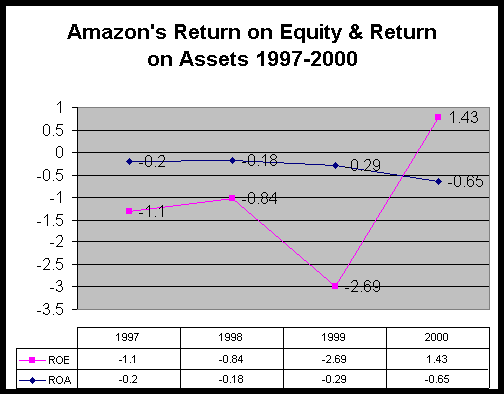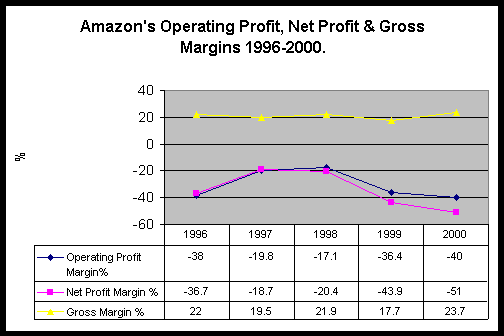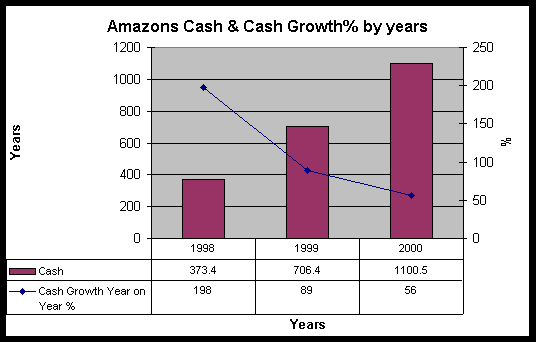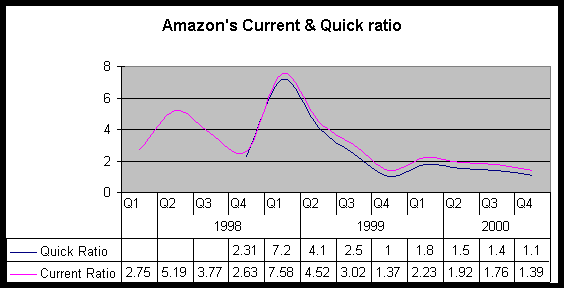
Return on Equity

Return on Equity is a measure of whether or not the management have operated the company well. One would have to view the ROE results as particularly poor and odd. Amazons ROE in 1999 dropped to –2.69, which was a percentage, drop of –270.4%, which is well below its 5-year average of –125.5% and is also substantially below the industry five-year average of 31.80%.
When one looks at the ROE decomposed for 1999, the biggest swing was seen in gearing which jumped 97.8% from 197 (4.69 to 9.28). The main reason for this was managements constant reinvestment policy which saw them gobble up several smaller ecommerce companies to spread their portfolio. A question mark would hang over the inflated valuation of some of these investments, especially in the light of the ‘bombing’ of several dotcom companies. Two of these investments were mistakes as described CEO Jeff Bozos who said in 1999:
"Investing in Living.com, which isn’t, and in Pets.com which is a dog!"
Living.com went bust in 2000.
As a result, Amazons long-term debt went from $348.1 Million in 1998 to $1466.3M in 1999 (increase of 321%). This debt increased in 2000 to $ 2127.5M and along with accounts payable increasing by 314% from 1998 to 2000 ultimately leads to a negative leverage of –2.2 in 2000.
Operating margins, Net Profit margins and Gross margins

These margins are all performing inadequately (except for gross margin) in the last number of years. This is mainly due to a number of factors.
However, by February 2001, Amazon announced that they would be closing two centres fully and closing one seasonally with a loss of 300 jobs (15% of workforce) as Amazon now seem to be beginning to focus on margins. Redundancies and other changes will cost Amazon $150 Million for the first half of 2001.
|
|
|
Liquidity Analysis
By analysing the liquidity of a company we can evaluate the risk associated with each company mainly through its ability to generate liquid cash flow and its ability to repay their current liabilities if situations become adverse. With Amazon, the most worrying of all of their financial ratios, the analysis of their liquidity situation is extremely worrying, especially from the creditors point of view.
In short, the following ratios for Amazons liquidity are all moving in a decreasing pattern: Working Capital, Sales, Quick Ratio, Current Ratio, Cash, Inventory and Cash Flow per Share.
|
|
|
|
Despite sales increasing, the growth rate of cash and marketable securities have not increased in line with rate of sales

Amazon love boasting about how much cash they have, but realistically speaking they must look at the bigger picture of perhaps working capital figures to see all the liabilities they have to pay with this cash. As the graph shows, working capital has decreased from $1.3Billion in the Q1, 1999 to $386M in Q4, 2000. (A drop of 243% in working capital. This has put a squeeze on creditors with accounts payable of $32.7 Million in 1997 now reaching $485.4M in 2000 (a 1415% rise 1997-2000(with the situation only going to get worse.
On the plus side for Amazon, because of it negative operating cycle which means that Amazon gets paid for its inventory (usually by credit card by the customer) long before it has to pay for inventory. In other words, Amazon gets the cash first and only then buys from publishers on credit. As a result Amazon has about 30 days which to put the money to productive use. Therefore, once sales remain reasonably solid, cash should be constantly flowing in, but one would wonder if this cash flow would be substantial enough.
Quick Ratio

Quick ratio measures the firm’s ability to repay current liabilities at short notice with cash and short-term investments. This has reduced dramatically in recent years from 7.2 (Q1, ’99) to 1.1(Q4, 2000), but this is mainly because of poor inventory management in 1999 when Amazon totally misjudged the amount of inventory they had fro Christmas 1999, which led to a $39 M write off of stock. Presumably management had problems judging how much sales would be for that quarter (Q4, ’99) as they had reached an all time high in terms of inventory/sales of 32.6%, which was a gross overestimation. The corresponding 4th Quarter ratio in 2000 was at 18% so perhaps a combination of prudence, better chain management and greater sales estimation was shown by management in this respect. In the 4th Quarter report of 2000, Amazon put a nice positive spin on this gross error by stating that:
"While net sales grew 44% for the quarter, inventory declined 21% from the previous year to $175M reflecting an improvement in asset turnover".
In reality, things couldn’t have got much worse in terms of asset turnover.
It is quite clear that the market is portraying a lot of sceptism about Amazon.com. Many analysts believe that Amazon is heading into dangerous waters, despite being the unquestioned king of online shopping. To become successful, Amazon may need to link up with an established Bricks and Mortar Company who could boost cash flows but also increase even further Amazons marketing appeal and brand worth. This was seen to great effect on the 4th of March 2000, when speculation mounted that Amazon were about to link up with the worlds largest retailer, Wal-Mart which drove up stock by more than 25% and adding more than $900 Million in market value. There has also been speculation about a possible tie up between German media giants Bertelsmann.